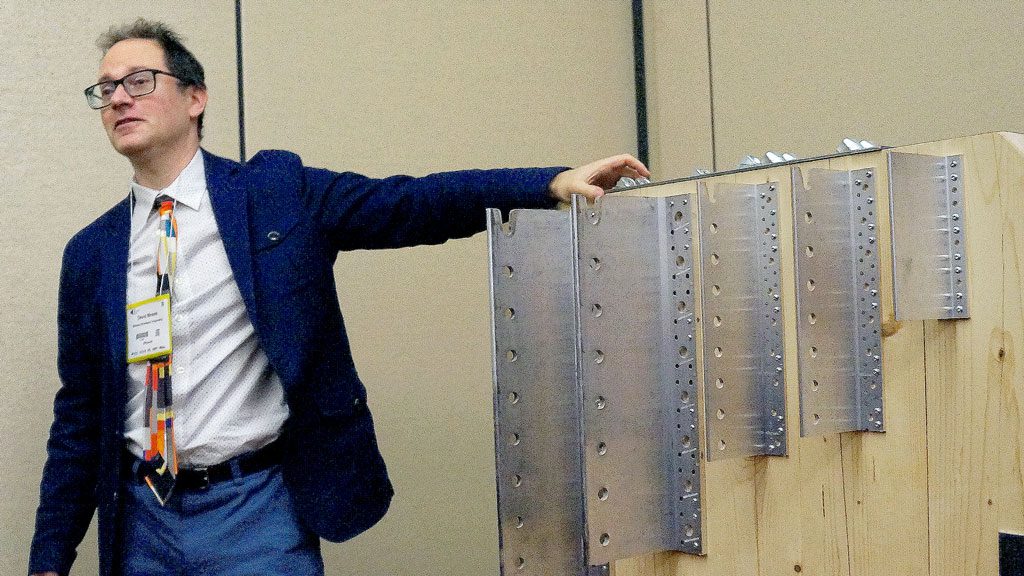As architects and engineers get up to speed on designing buildings in the fledgling mass timber industry in Ontario, many contractors remain on the sidelines hesitant about the new building type they are hearing more about.
“Right now, really the need is that we have trained people who know how to build,” said David Moses, principal with Moses Structural Engineers.
Working with Ontario’s Ministry of Natural Resources and Forestry, Carpenters’ Local 27 and the College of Carpenters and Allied Trades (CCAT), Moses is developing several mass timber modules that can be built and disassembled by apprentices and carpenters.
The full-scale modules will be at the heart of a four-week training course starting up next March at the CCAT in Vaughan.
One of the modules is a tilt-up balloon frame cross-laminated timber (CLT) stair shaft.
CLT proponents say they are easy to install and are fastened with screws, Moses recently told delegates at a mass timber seminar at The Buildings Show in Toronto.
A full-scale two-storey working model that “looks like a house” will expose students to “the many interfaces” in mass timber buildings, he said. Students will learn how to frame headers, attach ledgers and roofs. Another module illustrates various bracing options, including chevron, cross, k-bracing and CLT shearwalls.
Moses added that a small-scale module of an eight-storey mass timber building will help students and others understand the various systems and materials in a mass timber structure.
Design flexibility is paramount in mass timber structures. The ability to disassemble and reassemble with design revisions is one of the benefits of the system, he said.
“These buildings are built with a thought to the future.”
But the mass timber industry is still in its infancy, evolving and experiencing growing pains.
Material manufacturers produce products with a range of grades and dimensions designed to do the same thing.
“That lack of standardization makes it difficult for us,” he said.
Tony Currie, program director of the CCAT, stressed the importance of preparing a trained workforce for the sector.
“Labour really can make or break a job,” he said, noting the quality of the industry’s workers will help to determine how bright its future is.
He said the four-week course won’t be for every apprentice or journeyperson. Understanding how to build mass timber structures involves some complex math calculations. Learning load paths, lateral resistance and other elements will be part of the curriculum.
Fastening systems can’t be taken lightly either, Currie pointed out at the seminar.
“It’s not just a matter of picking any screw,” he said. “You have to look at the details, follow the drawings and use the correct fastening equipment.”
He added wood has to be handled carefully during construction.
“It has to look good when it is installed” because it is often left exposed in completed buildings, he added.
Currie, who is open to input on the course curriculum from various building and design disciplines, said the first four-week course is slated for March.
Mike Yorke, president of the Carpenters’ Local 27, told delegates there are “huge opportunities” in Ontario’s north for the development of a mass timber industry.
“We have many mills, many towns that are in trouble. We could tie in Ontario’s colleges and universities and involve a proper forest management system,” Yorke said, noting Ontario needs to get off the sidelines as other countries develop the industry.
He said materials such as CLT are not available in Ontario. A Shoppers Drug Mart under construction in downtown Toronto, for example, has CLT for floor slabs and the elevator core which are supplied by an Austrian manufacturer.
Yorke and Currie were part of a team that toured mass timber projects in Europe. At a multi-building development near Vienna several CLT buildings are rising, including one at 24 storeys.
CLT factories, meanwhile, are growing in Europe, Yorke said, pointing to a factory in Italy that employs hundreds of people.
“This is a high-quality, highly sophisticated product that they are selling to the world,” he said.
“We (Ontario) are missing out on the supply chain on CLT and glue lamination. The manufacturing plants are not here, but other people (countries and provinces such as B.C. and Quebec) are leading the way.”











Recent Comments